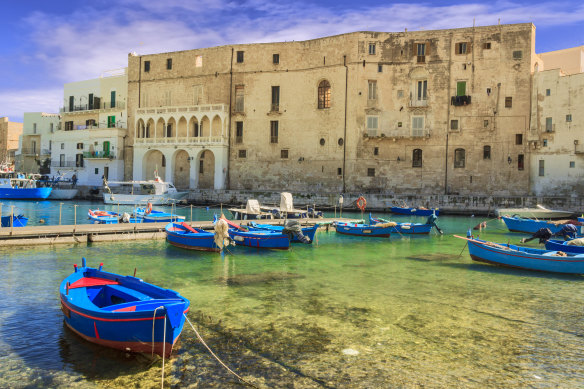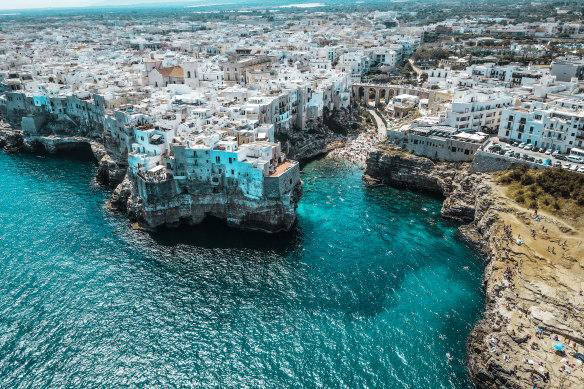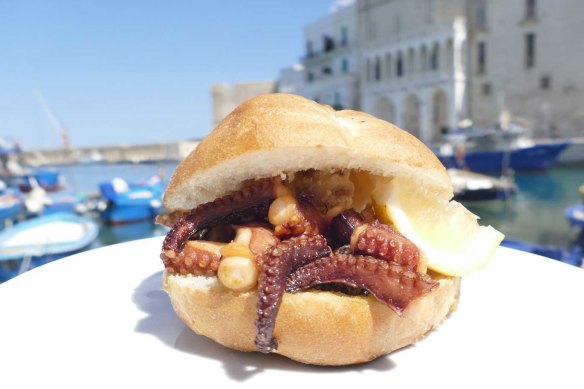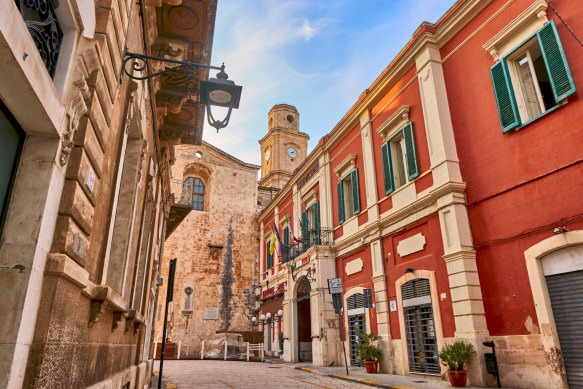There’s a real-life Monopoli, and it’s not what you think
“People ask me if there’s any relation to Monopoly [the board game],” says Eustachio Cazzorla, local journalist and tour guide of Free Walking Tour Italia, as we enter the information centre, once a bustling fish market. A Monopoly board game, the Monopoli edition, sits proudly beside a stack of Puglia travel brochures.
“Monopoli’s namesake predates the game by centuries. It comes from the Greek word ‘Monopolis,’ meaning ‘unique city.’”

The turquoise shores of Porto Vecchio, the beating heart of Monopoli.Credit: Getty Images
I’ve come to Monopoli by pure chance. After being fed up with the overcrowded streets of Florence, my fiance and I pointed at a map, at random, landing on Monopoli, a small Puglian town perched on the Adriatic Sea we’ve called home for a month now.
The Porto Vecchio is the beating heart of Monopoli, a town founded on the sea and from the sea, as the locals say. Here, the air thrums with the energy of fishermen unloading their day’s bounty. Red and blue rowing boats (gonzo) bob like painted corks.
During a walking tour, Cazzorla introduces me to Giuseppe Danese, who ferries tourists on fishing trips and to the more-famous seacliff town of Polignano a Mare on his boat, My Wave. Like most tourism operators here, Danese doesn’t speak English. “The town is still establishing itself for international visitors,” says Cazzorla.
Danese and another fisherman invite us on board; their dialect is a secret language, even to Cazzorla, who tells me a story of when Danese was a boy. In 1971, a group of Monopoli fishermen, including Danese’s father and himself, rescued passengers from the burning Greek ferry, Heleanna.

Mouthwash-blue water surrounding Polignano a Mare.Credit: Getty Images
“The story is told in the bas-relief on Castello Carlo V,” says Cazzorla, pointing to the etching in stone nearby. The city was awarded the prestigious Silver Medal of Civil Merit for the rescue.
Twenty minutes elapse. Their laughter, punctuated by gestures that paint pictures in the air, tells a story more vividly than words I could translate. Monopoli’s fishermen seem to belong entirely to this world, governed by the sea’s rhythm. Danese goes by Giuseppe on land, but out there, he is known as “The Greek.”

Panino col polpo (octopus sandwich), best enjoyed at the scenic marina.Credit: Kartocc
The seafaring culture is the lifeblood of Monopoli. Fresh fish, octopus and prawns can be bought directly from the boats moored in port, which also supply local restaurants. My favourite way to enjoy the local catch is a panino con polpo (octopus sandwich) from Kartocc. The octopus is lightly battered and fried and stuffed in a panini with tomatoes, stracciatella and zucchini – best enjoyed in the port, with feet dangling over bobbing boats below.
In the past 15 years, Monopoli has shifted to tourism, with fisherman homes now Airbnbs and B&Bs. The main street in the old town once only had three restaurants, explains Cazzorla, as we wander down the now bustling epicurean cobblestone avenue. Surrounding it is a labyrinth of narrow laneways, opening out to ancient squares bathed in that iconic honey-coloured limestone.
Walking along the Lungomare seafront promenade, a fortified wall constructed between the seventh and ninth centuries, the architecture shifts from Puglian to Greek, with whitewashed buildings and Santorini-blue doors. I learned from Cazzorla that Monopoli was passed around from ruler to ruler, starting with the Greeks, which is why the eastern part of the town feels like a Greek Island. There’s even a clear blue beach under the ancient wall to convince you.

The charming back streets of Monopoli.Credit: Getty Images
It wasn’t just the Greeks who contributed to the look of Monopoli. The Byzantines, Cretans, Spaniards, and even Venetians left their signature. There’s no better place to experience it then standing under the imposing Cattedrale Maria Santissima della Madia, dedicated to the Madonna della Madia and one of the finest examples of Baroque-Romanesque architecture in the region.
There’s little by way of tours and attractions here that are found in other Puglian towns. But surrendering to the rhythm of Monopoli is the best way to experience it.
That means taking a dip in one of its many sparkling clear water beaches nearby and joining the locals in la passeggiata, the sacred pre-dinner stroll, in the Piazza Vittorio Emanuele II.
The details
Fly
Qantas flies from Sydney to Rome with a connection in London. Take the Espresso Salento, an overnight rail service from Rome to Puglia, which arrives in Monopoli mid-morning. Alternatively, take a day Trenitalia service to Monopoli from Roma Termini (five hours). See qantas.com.au; italiarail.com
Stay
 Chése De Menòple is a self-contained apartment with enviable views of the bell tower in the old town. From €80 ($130) a night. See booking.com
Sign up for the Traveller Deals newsletter
Get exclusive travel deals delivered straight to your inbox. Sign up now.